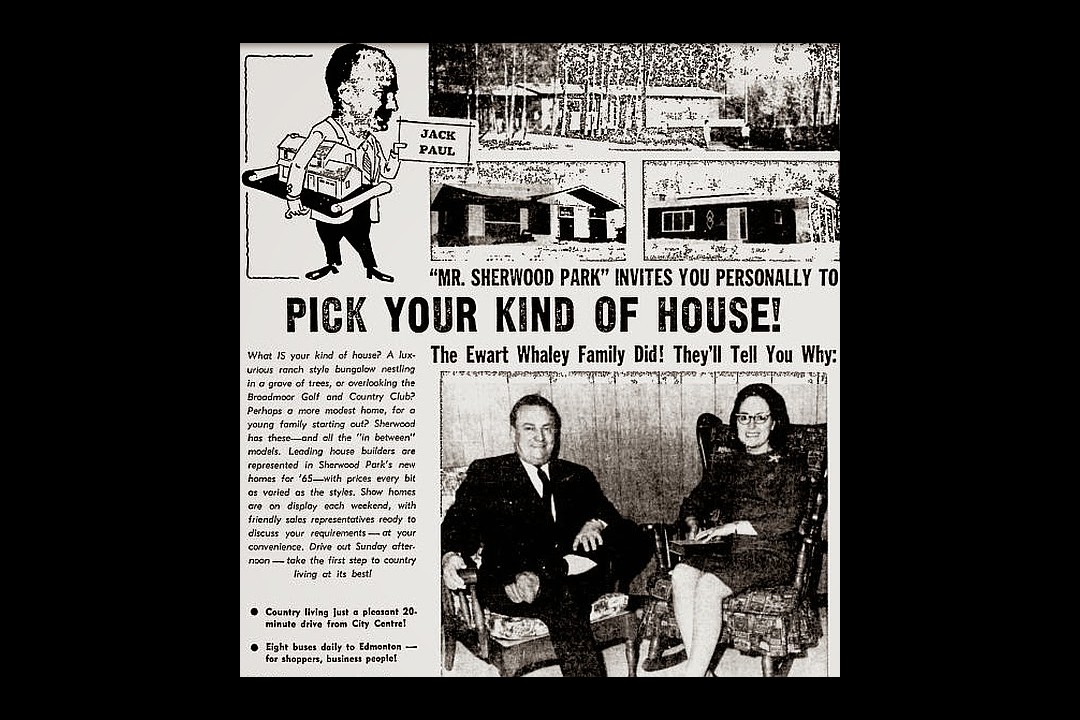On this day in 1965, developers were trying to tempt homebuyers to move to the growing exurb of Sherwood Park.
Many of the villages, towns, and cities in the Edmonton region first sprang up between the 1850s to the early 1900s. But Sherwood Park got its start in 1951. That year, developers John Hook Campbell and John Mitchell sought approval to carve out space for a new country-residential community in Strathcona County. The pair originally pitched the idea of building around 100 homes on what was then farmland. The hope was to appeal to buyers who worked in the newly built refineries east of Edmonton. The Municipal District of Strathcona approved the plan in 1953. And within a couple of years, the first model homes were ready for the public.
But the community was not yet called Sherwood Park. When the first handful of families moved in during the winter of 1955, the hamlet went by Campbelltown, named after one of the developers. Yet that name wouldn't stick for long. In 1956, Canada Post demanded Campbelltown change its name. There was already a Campbelltown in New Brunswick, as well as one in Scotland and a couple in Australia, and this made mail delivery confusing. So, Sherwood Park was born. The name is a direct reference to the Sherwood Forest that featured in the stories of Robin Hood.
Prospective homebuyers were lured out to the nascent community with promises of "an entirely new way of living," according to one marketing brochure from the 1950s. Among the touted benefits were "50% lower taxes," "all-weather paved roads," and "the finest homes ever seen in Canada." Buyers were offered the choice of 68 Ranch-style home designs.
But despite the lofty promises, Sherwood Park's earliest residents had a rough experience. Sidewalks and streetlights were not in place. Telephone service didn't exist. Electricity was unreliable. The spring of 1956 brought new challenges, too. The water mains installed in the winter ended up bursting when the ground thawed, forcing many residents to rely on melted snow to flush toilets. And while the pipes might have been dry, the ground was not. Heavy rain and snow meant a wet summer, which turned the unpaved streets into a muddy mess. Freeing stuck vehicles became a regular occurrence for early Sherwood Park residents.
Despite these challenges, the community grew. A general store opened in 1955, and other businesses soon followed. For the first few years, Sherwood Park relied on a volunteer firefighting force — which was made up almost entirely of women. Most of the men in the community worked in factories, meaning they were in Edmonton during working hours. Women who did not work outside the community filled in the gap.
By 1959, Sherwood Park had swelled to 500 homes. That year saw the construction of the community's first firehall, its second school, and other services to cater to its growing population. New highway construction in the 1960s made it easier to commute between Sherwood Park and Edmonton, fuelling growth.
Sherwood Park listed a population of roughly 72,000 people in 2021. If it were a city, that would make it Alberta's sixth-largest. But, despite its city-like size, Sherwood Park never gave up its status as a hamlet. It's often said to be the largest hamlet in the world. It doesn't have its own government, instead falling under the umbrella of Strathcona County. To deal with the need to fund and provide services to such a large centre, the province has designated Sherwood Park as an "urban service area" that is often treated as a city. (It shares this title with Alberta's other seems-like-it-would-be-a-city-but-actually-isn't place, Fort McMurray.)
Sherwood Park has changed dramatically from those four model houses surrounded by muddy roads 70 years ago. This very (very) large hamlet continues to deal with a growing population and demand for more services. Just last month, Strathcona County agreed to a deal that would see an $85-million dollar multipurpose arena built in Sherwood Park, aimed to open in 2026.
This clipping was found on Vintage Edmonton, a daily look at Edmonton's history from armchair archivist @revRecluse of @VintageEdmonton.

